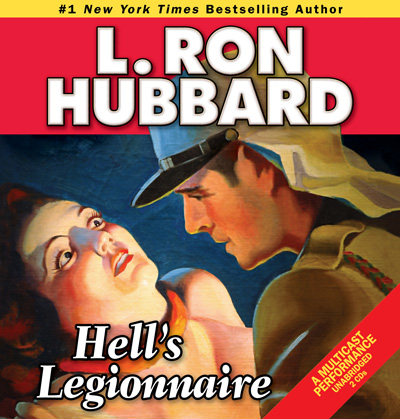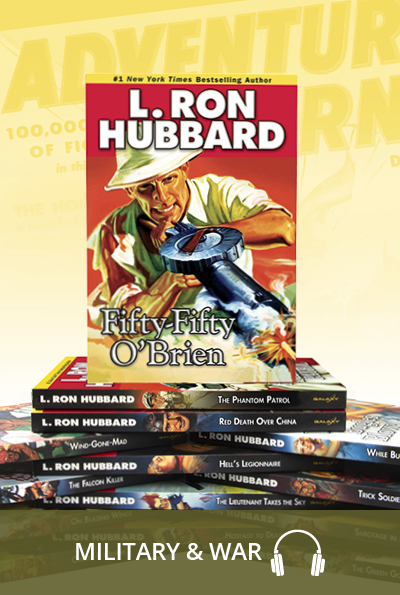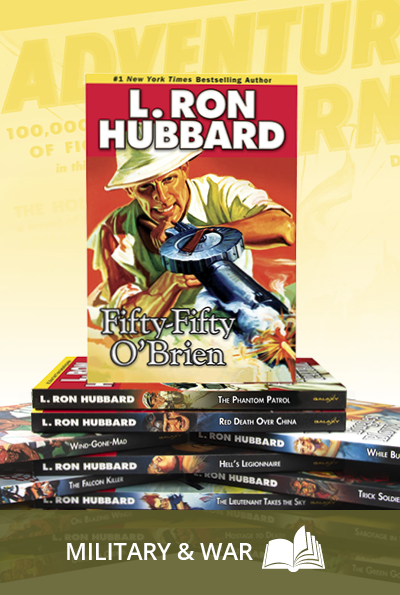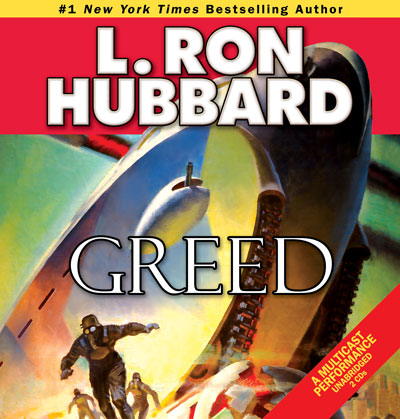American Ann Halliday is as fiery as the Sahara sun. And now she’s feeling some real heat, as the prize captive of the Berber leader Abd el Malek also known as “The Killer.”
But Abd el Malek wants Ann alive—and in chains—subject to his every whim and fantasy. Dusty Colton, however, an American deserter from the French Foreign Legion, has a different idea and he’s determined to give “The Killer” a taste of his own bloody medicine. The only problem is Dusty himself is wanted for murder.
Can Ann and Dusty team up and turn evil on its head? One thing’s for sure—between Ann and the Hell’s Legionnaire, the temperature is about to get even hotter.
Also includes the adventure stories, “The Barbarians,” in which a Legionnaire sets out to avenge a savage killing and makes a stunning discovery; and “The Squad That Never Came Back,” the story of a man who has uncovered the secret to a city of gold—a secret that could turn into a death sentence.
Performers: R.F. Daley (narrator), Phil Proctor, Gino Montesinos, Brooke Bloom, Michael Yurchak, Jim Meskimen, and Enn Reitel.
“Action-packed … standout … hard-core graphic.” —Library Journal
SAMPLE
ABOUT THE AUTHOR
On the subject of North Africa, L. Ron Hubbard said that writers too often “forget a great deal of the languorous quality which made The Arabian Nights so pleasing. Jewels, beautiful women, towering cities filled with mysterious shadows, sultans equally handy with robes of honor and the beheading sword.” Mr. Hubbard brings this unique insight to his stories of North Africa and the Legionnaires, investing them with an authenticity of time, place, and character that will keep you asking for more.
Hell’s Legionnaire Glossary
Stories from the Golden Age reflect the words and expressions used in the 1930s and 1940s, adding unique flavor and authenticity to the tales. While a character’s speech may often reflect regional origins, it also can convey attitudes common in the day. So that readers can better grasp such cultural and historical terms, uncommon words or expressions of the era, the following glossary has been provided.
alidade: a topographic surveying and mapping instrument used for determining directions, consisting of a telescope and attached parts.
altimeter: a gauge that measures altitude.
Atlas: Atlas Mountains; a mountain range in northwest Africa extending about fifteen hundred miles through Morocco, Algeria and Tunisia, including the Rock of Gibraltar. The Atlas ranges separate the Mediterranean and Atlantic coastlines from the Sahara Desert.
azimuth: in artillery, the angle of deviation of a projectile or bomb from a known direction, such as north or south.
bandoliers: broad belts worn over the shoulder by soldiers and having a number of small loops or pockets, for holding cartridges.
bataillon pénal: (French) penal battalion; military unit consisting of convicted persons for whom military service was either assigned punishment or a voluntary replacement of imprisonment. Penal battalion service was very dangerous: the official view was that they were highly expendable and were to be used to reduce losses in regular units. Convicts were released from their term of service early if they suffered a combat injury (the crime was considered to be “washed out with blood”) or performed a heroic deed.
Berbers: members of a people living in North Africa, primarily Muslim, living in settled or nomadic tribes between the Sahara and Mediterranean Sea and between Egypt and the Atlantic Ocean.
burnoose: a long hooded cloak worn by some Arabs.
cafard: (French) a mood of madness and suicidal depression that commonly afflicted Legionnaires.
caid: a Berber chieftain.
cantle: the raised back part of a saddle for a horse.
Casablanca: a seaport on the Atlantic coast of Morocco.
Caudron: airplane made by the Caudron Airplane Company, a French aircraft company founded in 1909 by Gaston (1882–1915) and René (1884–1959) Caudron. It was one of the earliest aircraft manufacturers in France and produced planes for the military in both World War I and World War II.
Chauchat: a light machine gun used mainly by the French Army. It was among the first light machine-gun designs of the early 1900s. It set a precedent for twentieth-century firearm projects as it could be built inexpensively in very large numbers.
coyote: used for a man who has the sneaking and skulking characteristics of a coyote.
deuce, what the: what the devil; expressing surprise.
djellaba: a long loose hooded garment with full sleeves, worn especially in Muslim countries.
drome: short for airdrome; a military air base.
Fez: the former capital of several dynasties and one of the holiest places in Morocco; it has kept its religious primacy through the ages.
flintlock: a type of gun fired by a spark from a flint (rock used with steel to produce an igniting spark). It was introduced about 1630.
Foreign Legion: French Foreign Legion; a unique elite unit within the French Army established in 1831. It was created as a unit for foreign volunteers and was primarily used to protect and expand the French colonial empire during the nineteenth century, but has also taken part in all of France’s wars with other European powers. It is known to be an elite military unit whose training focuses not only on traditional military skills, but also on the building of a strong esprit de corps amongst members. As its men come from different countries with different cultures, this is a widely accepted solution to strengthen them enough to work as a team. Training is often not only physically hard with brutal training methods, but also extremely stressful with high rates of desertion.
Franzawi: (Arabic) Frenchman.
G-men: government men; agents of the Federal Bureau of Investigation.
hein?: (French) eh?
High Atlas: portion of the Atlas Mountain range that rises in the west at the Atlantic coast and stretches in an eastern direction to the Moroccan-Algerian border.
houris: in Muslim belief, any of the dark-eyed virgins of perfect beauty believed to live with the blessed in Paradise.
hp: horsepower.
ifrīts: (Arabic) powerful evil jinn, demons or monstrous giants in Arabic mythology.
Jebel Druses: Jebel is Arabic for mountain. The Druse (also Druze) are members of a tightly organized, independent religious sect dwelling in the Jebel Druze State, a region in southern Syria named after the Jabal el Druze mountain and formerly part of the Turkish Empire. They have been known to be strong fighting people.
kepi: a cap with a circular top and a nearly horizontal visor; a French military cap that men in the Foreign Legion wear.
kohl: a cosmetic preparation used especially in the Middle East to darken the rims of the eyelids.
la Légion: (French) the Legion; the French Foreign Legion.
Lawrence: Lieutenant Colonel Thomas Edward Lawrence, also known as T. E. Lawrence. A British Army officer renowned especially for his liaison role during the Arab Revolt against the Ottoman Turkish rule of 1916-18. Extraordinary breadth and variety of his activities and associations, and his ability to describe them vividly in writing, earned him international fame as Lawrence of Arabia, a title which was used for the 1962 film based on his World War I activities. Lawrence’s major written work is Seven Pillars of Wisdom. In addition to being a memoir of his war experiences, certain parts also serve as essays on military strategy, Arabian culture and geography.
Lebels: French rifles that were adopted as standard infantry weapons in 1887 and remained in official service until after World War II.
Legion: French Foreign Legion, a specialized military unit of the French Army, consisting of volunteers of all nationalities assigned to military operations and duties outside France.
Legionnaire: a member of the French Foreign Legion.
light out: to leave quickly; depart hurriedly.
lucre: money, wealth or profit.
mailed fist: superior force.
Makhzan: (Arabic) the privileged people from whom the Moroccan state officials are recruited.
Mannlicher: a type of rifle equipped with a manually operated sliding bolt that loads cartridges for firing. Ferdinand Mannlicher, an Austrian engineer and armaments designer, created rifles that were considered reasonably strong and accurate.
mes amis: (French) my friends.
mon Dieu: (French) my God.
Moorish barb: a desert horse of a breed introduced by the Moors (Muslim people of mixed Berber and Arab descent) that resembles the Arabian horse and is known for speed and endurance.
Moors: members of a northwest African Muslim people of mixed descent.
Morocco: a country of northwest Africa on the Mediterranean Sea and the Atlantic Ocean. The French established a protectorate over most of the region in 1912, and in 1956 Morocco achieved independence as a kingdom.
m’sieu: (French) sir.
Mt. Tizi-n-Tamjurt: the highest elevation in the Atlas Mountain range.
murette: (French) a low wall.
musette: a small canvas or leather bag with a shoulder strap, as one used by soldiers or travelers.
paquetage: (French) soldier’s pack.
prop wash: the disturbed mass of air pushed aft by the propeller of an aircraft.
Riffs: members of any of several Berber peoples inhabiting the Er Rif, a hilly region along the coast of northern Morocco. The Berber people of the area remained fiercely independent until they were subdued by French and Spanish forces (1925–1926).
Scheherazade: the female narrator of The Arabian Nights, who during one thousand and one adventurous nights saved her life by entertaining her husband, the king, with stories.
scow: an old or clumsy boat; hulk; tub.
Shilha: the Berber dialect spoken in the mountains of southern Morocco.
sīdī: (Arabic) a general title of respect.
Sidi-bel-Abbès: the capital of the Sidi-bel-Abbès province in northwestern Algeria. The city was developed around a French camp built in 1843. From 1931 until 1961, the city was the “holy city” or spiritual home of the French Foreign Legion, the location of its basic training camp and the headquarters of its first foreign regiment.
Snider: a rifle formerly used in the British service. It was invented by American Jacob Snider in the mid-1800s. The Snider was a breech-loading rifle, derived from its muzzle-loading predecessor called the Enfield.
sou: (French) a French coin worth a very small amount.
Toledo: Toledo, Spain; a city renowned for making swords of finely tempered steel.
turtleback: the part of the airplane behind the cockpit that is shaped like the back of a turtle.
Zephyrs: penal battalions for the French Foreign Legion; nickname given in Algeria to a corps that is recruited from the French Army, those who would not conform to discipline or who were criminals. This punishment, no matter its length, does not count in the term of military duty which the state requires.











